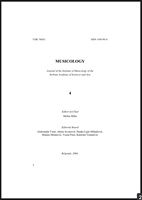Стилске координате ораторијума „Васкрсење“ Стевана Христића(1912) и питање раскршћа традиција у српској музици 20. века
Stylistic Directions in Stevan Hristić’s Oratorio “Vaskrsenje” (“Resurrection"). The Question of Crossroads-Traditions in Serbian Music at the Beginning of the 20th Century
Author(s): Katarina TomaševićSubject(s): Music, Sociology of Art, History of Art
Published by: Muzikološki institut SANU
Keywords: Stevan Hristić; Miloš Milojević; oratorio Resurrection; national style; musical Modern;
Summary/Abstract: Vaskrsenje (Resurrection) which was composed by Stevan Hristić (libretto Dragutin Ilić) was a first oratorio in Serbian music. The libretto was published in a journal Odjek (Echo) in 1909, with the first performance in 1912 at the Belgrade National Theatre. During the period 1909-1912, the young composer studied church music in Moscow and Rome. He studied with Dom Lorenzo Perosi in Rome, who was a director of the Sistine Chapel at the time, and a leading composer of church music. Perosi also composed two oratorios with the Resurrection as a subject-matter. His stay in Rome, as well as the encounter with the contemporary Italian style of church music left a strong impression on Hristić and his later opus. The oratorio Resurrection is freely permeated with both romantic and impressionist elements, hence the impression of the typically Western fin-de-siecle style. Compared to Serbian performances until that time, Hristić’s work represented a complete novelty in its style and genre; it was considered as one of the first works of Serbian musical Modernism. Despite the audience’s positive reception, the oratorio was faced with a highly negative criticism of Jovan Zorko and Miloje Milojević. Both of them criticized Hristić for not having composed the work in the spirit of “national music”. Hristić defended his poetics claiming that the idea of composing a national music did not comprise the use of folk melodies, but rather composing according to the highest professional and aesthetic criteria. A debate which was anticipated concer¬ning the meaning and the importance of “national” poetics arose as a reaction to Resurrection. This debate remained important in two ways: 1) it remained a “typical” debate for the dynamic development of Serbian music following the World War I and 2) it became the central characteristic of the overall artistic development in Serbia during the interwar period, which was “coming close” and eventually became the part of Europe.
Journal: Muzikologija
- Issue Year: 1/2004
- Issue No: 4
- Page Range: 25-37
- Page Count: 13
- Language: Serbian

